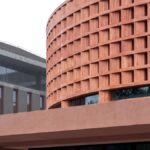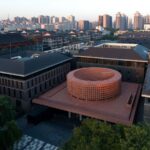Situated at the entrance of Xi’an’s Datang Everbright City, adjacent to the renowned Giant Wild Goose Pagoda, the Qujiang Museum of Fine Arts stands as a cultural landmark. Tasked with creating an architectural icon for the museum’s East Entry, Neri&Hu Design and Research Office embarked on a journey to weave tradition with modernity, crafting a structure that not only accommodates the museum’s expanding functions but also resonates with the city’s rich social history.

Blending Past and Present
Embracing the concept of a monolithic urban monument, the design seeks to integrate seamlessly with the existing gallery spaces, minimizing disruption to the surrounding architectural landscape. Comprising four distinct elements – the Base, Sculptural Walk, Platform, and Monument – the building harmonizes solidity with transparency, tradition with innovation.
A Grounded Foundation
The Base, constructed primarily of cast-in-place concrete, serves as a communal ground, inviting visitors to explore its sunken realms. Retaining original features such as wide steps, the Base houses a blend of retained and newly introduced functions, seamlessly integrating with the adjacent pedestrian street.
Ascending Dramas
Escalating from the plaza, sculptural escalators lead to the underground museum, concealed within a play of light and shadow. Above, the Platform hovers delicately, supported by a grid of stone columns and glass curtain walls, delineating a clear distinction between the carved language of the base and the civic grandeur of the upper levels.

Monumental Expression
Crowning the structure, the Monument exudes elegance with diamond-shaped red travertine masonry units, enhancing the play of light and shadow. The second-floor lounge opens onto an outdoor amphitheater, offering a dynamic space for public gatherings and private events alike.
A Symphony of Tradition and Innovation
In the Qujiang Museum of Fine Arts Extension, Neri&Hu Design and Research Office has crafted more than a building; they have created a symphony of tradition and innovation, a timeless testament to the enduring spirit of cultural heritage.
















